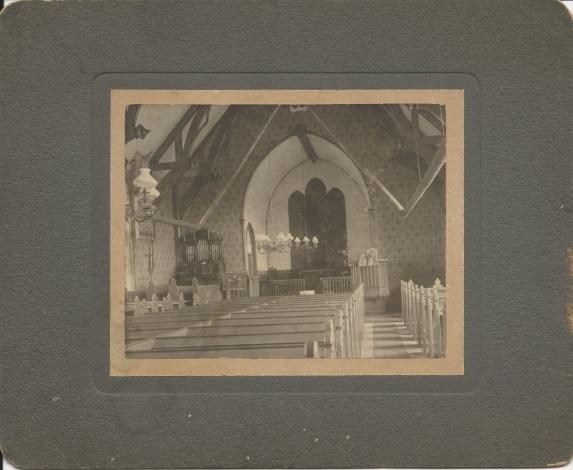
The history of the Anglican Church in the former Moore Township can be traced back at least as far as June 22, 1835. On that day, a meeting was held in Thomas Sutherland’s warehouse, along the river at Sutherland’s Settlement, to discuss the foundation of a congregation. Thomas Sutherland was a refined and educated gentleman who ran a tailoring business in Edinburgh for many years. In 1832, however, he came to Canada and bought land along the St. Clair River from a French squatter named Gallineau. Realizing that a tailoring business would fail in the pioneer circumstances, Thomas Sutherland went to work to establish a lumber and shipping business, a warehouse, and a trading store. Thomas Sutherland was a very community-minded man. His home was the stopping place for many new settlers arriving in the area. He also established a library in his home and a Sunday School in his warehouse. The people in the area depended on travelling missionaries and visiting ministers for their religious life. Often these ministers would hold services in Sutherland’s orchard, home, or buildings.
When a neighbour of Sutherland’s died, Thomas was distressed that there was no consecrated land to bury him on. As a result, Thomas Sutherland immediately donated “God’s Acre” for use as an Anglican cemetery, as well as enough timber to build a church. It was these events which gave rise to the discussion meeting in June 1835.
As a result of this meeting, a two storey building was erected to serve the dual purpose of a temporary church and school. Work for a permanent church building continued but construction was delayed as a result of the Rebellion of 1837. Finally, on June 21, 1841, Thomas Sutherland laid the first brick for the church which was completed by that January. The church opened January 23, 1842 and was largely financed by Sutherland himself.
There were no sawmills or other conveniences to aid in preparing the construction materials. Logs were hewn by the hands of volunteer labourers and the bricks were made by hand as well. People donated what they could of time and money and Mr. Sutherland himself made up the difference of the cost with £600. The completed church was of brick construction with oak logs as foundations. The church had a large center aisle and a capacity of 200 to 300 people. The steeple was made of glittering block tin and thus also served as a guide to ships before government buoys and lights.
The first public worship service in the new building took place on Jan. 23, 1842 under the enthusiastic leadership of Rev. Alexander Pyne from England. The opening ceremony was the first event of its kind in the area and people flocked to the church from all over the township parish to participate. They arrived on foot and in conveyances of every kind to crowd and overflow the church. When Thomas Sutherland returned to the area after a visit to England, he brought with him gifts to help furnish the church. John Ruskin and Benjamin Disraeli, friends of Thomas Sutherland, presented him with the first communion plate and altar linens for the Holy Trinity Church. The Ruskins also presented an inscribed silver Sheffield communion service consisting of a flagon, paten and chalice. The deed to the new church and its land was formally presented to Bishop Strachan in 1845 when Thomas Sutherland returned from England. He had left on the trip with the deed accidentally in his pocket.
For some time the church was without a Rector, but the Rev. Pyne organized a Sunday School. This was of great importance since Sunday School was often the only education available to some settlers. The first parish was extremely large and included Froomefield, Sarnia, Mooretown and Plympton. This was the case under the pastorate of Rev. G.J.R. Salter who came in 1847. He organized the first successful Sunday School picnic in the township.
After several other Rectors, Rev. David Armstrong arrived in 1860. He made many improvements to the church and cemetery. Despite these efforts, however, the church was settling on its log foundations as they slowly crumbled and rotted away. It was decided that the church was beyond repair, so in 1862 a new building committee was organized and they went ahead to construct a new church. Mrs. James Bâby donated land in Mooretown to replace the existing church and had the honour of laying the new cornerstone on May 25, 1863. This church was erected at an estimated cost of $2300 and was dedicated by Bishop Cronyn who was a frequent visitor and called Moore his “pet parish”. The architect and builder was Robert Mackenzie.
Financial support and other support for Trinity was lost when the Corunna and Courtright congregations began. The new church had been built by newer members of the congregation who did not have such a deep appreciation for the history and meaning of Sutherland’s first church. The old building was used as a cemetery chapel and was rumoured to be haunted. In reality, the children from St. Clair loitered there, scribbled their names on the church and broke glass. In 1881, the building was sold to J. Dunlop for $102. The original bell remained in the new Trinity church until it closed down.
Some of the prominent families in Trinity’s early history were the Biddles, Johnstons, Bells, Cunninghams, Geikies, Admiral Vidal and Froome Talfourd.
Unfortunately, disaster struck in 1918 when lightning destroyed the building, but the furniture and bell were saved, and a new church erected on the old site in 1919. C.F. Noyle was the contractor for the third Trinity Anglican Church. Mr. Ernest Dymond was the incumbent at this time, and remained there until 1922. He was followed by Rev. Hugh Crosby.
Rev. J. H. Whealen came in 1927, and was remembered for his effort in engaging younger parishioners. The largest Anglican Young People’s group in Lambton County was organized and functioned, due in part to Rev. and Mrs. Whealen’s support at this time. Rev. Whealen remained at the church until 1936, ,when he accepted a Rectorship at Ilderton. Following this, Rev. S. H. Coleman came to the church and remained there for four years.
In June of 1941, Rev. C. A. Selby came to the church. At this time, the church celebrated the 100th anniversary of the founding of the Anglican Church in Lambton County.
In the early 1980’s, the declining size of the congregation led to the closing of Trinity Anglican Church. It was subsequently used as an artist’s studio. In October 1998, the church was donated to Moore Museum by Chris and Lee Brandon of Mooretown. It was transported from Napolean Street, along Pulteney Street, to the museum site by Museum volunteers. Street and traffic signs had to be removed and replaced along the route, and special care taken to avoid power and telephone lines. Utility and township vehicles as well as museum staff and other personnel were present to assist in the relocation. The church was on the road for a total of two hours.
Renovations took place in the following years, with funds partially provided by the Corunna Br. 447 of the Royal Canadian Legion. Following renovations, the church was re-named Trinity St. Clair Chapel. A service for the blessing of the chapel was held on July 30, 2000. Much of the furniture was donated to Moore Museum where it is currently on display. The chapel is still used for tours, special events and weddings.
The site of the original Sutherland’s Trinity Church has been designated and clearly marked as an Ontario Historical Site.


